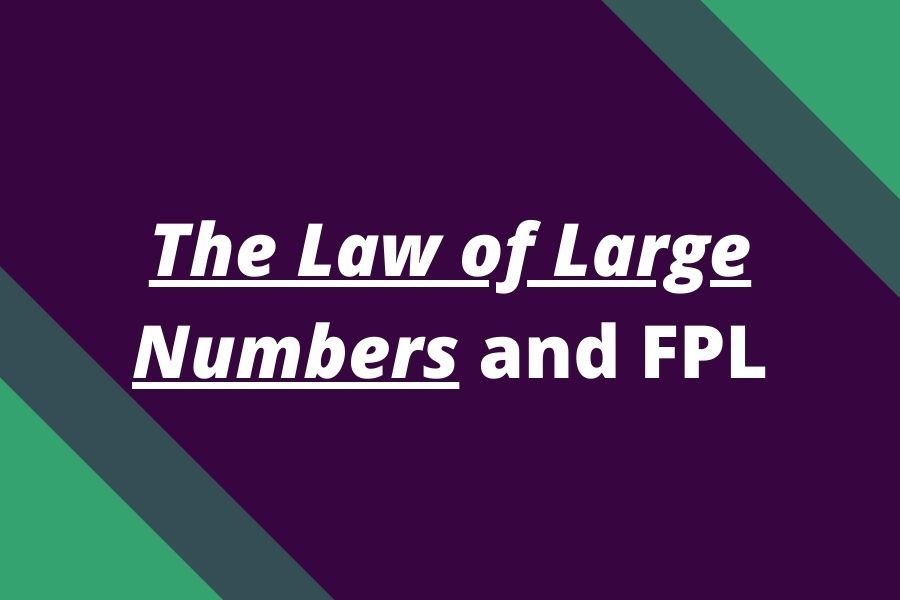The Law of Large Numbers is a fundamental principle in probability theory and statistics that describes the result of performing the same experiment a large number of times.
It’s a concept that has wide-ranging applications, from insurance to gambling, and even to the world of Fantasy Premier League (FPL).
In this article, we’ll explore the Law of Large Numbers and its intriguing role in FPL, providing insights into player and team performance and informing strategic decisions.
Understanding the Law of Large Numbers
The Law of Large Numbers states that as a sample size grows, the sample mean will get closer to the population mean. In other words, the more times an experiment is conducted, the closer the results will get to the expected value.
For example, if you flip a fair coin, the probability of getting heads is 0.5. If you flip the coin ten times, you might not get exactly five heads. But if you flip the coin a thousand times, or a million times, the number of heads is likely to be very close to 50% of the total flips.
This principle is fundamental to many areas of life.
In insurance, for example, companies rely on the Law of Large Numbers to predict the likelihood of events like accidents or illnesses across a large group of people.
In gambling, casinos know that while a player might win big in the short term, over a large number of games the house always has an edge.
The Law of Large Numbers in Fantasy Football
So, how does the Law of Large Numbers apply to FPL?
In FPL, managers select a team of real-life football players, and these players score points based on their performances in actual Premier League matches.
Short term points
Over a small number of matches, a player’s FPL points can be influenced by a range of factors, including luck. A player might score a goal off a deflection, or be awarded a penalty that they wouldn’t usually take.
Long term points
However, over a large number of matches, these lucky (or unlucky) events tend to even out, and a player’s FPL points will tend to reflect their underlying performance levels.
This is where the Law of Large Numbers comes in.
Over the course of a single match, or even a few matches, it can be difficult to predict how many FPL points a player will score.
But over the course of a season, or multiple seasons, patterns emerge.
High-performing players and teams will, more often than not, score more FPL points. The Law of Large Numbers helps us to see these patterns and make informed predictions about player and team performance.
Player Performance and the Law of Large Numbers
Let’s look deeper into player performance. In FPL, some players are consistently high scorers. These players tend to be skilled, play in attacking positions, and take on roles like set-piece taking that provide additional opportunities to score Fantasy Football points.
However, even these players can have matches where they score few or no points. They might have an off day, their team might play poorly, or they might just get unlucky.
Over a small number of matches, these fluctuations can make it seem like player performance is unpredictable.
But over a large number of matches, the Law of Large Numbers comes into play.
High-performing players will, on average, score more points than lower-performing players.
Their skill, role, and other factors will lead to more goals, assists, clean sheets, and bonus points. By understanding this, FPL managers can make more informed decisions about which players to include in their teams and which players to ignore.
Team Performance and the Law of Large Numbers
Just as the Law of Large Numbers applies to individual player performance in FPL, it also applies to team performance. Over the course of a season, a team’s performance can fluctuate due to a variety of factors, including injuries, changes in form, and the difficulty of their fixtures. However, over a large number of matches, these fluctuations tend to even out, and a team’s overall quality will generally be reflected in their results and, consequently, in the FPL points scored by their players.
For example, teams that consistently perform well in the Premier League, such as Manchester City or Liverpool, will generally have players who score high FPL points due to their high number of goals, assists, and clean sheets. Conversely, teams that struggle might have players who score fewer FPL points. Understanding this can help FPL managers make more informed decisions about which players to select based on their team’s performance.
Using the Law of Large Numbers to Make FPL Decisions
So, how can FPL managers use the Law of Large Numbers to help them with their decisions?
One way is by looking at a player’s or team’s performance over a large number of matches, rather than focusing too much on recent results. While a player might have a run of high-scoring matches, if their performance over a larger sample size is average, it might not be wise to expect them to continue their high-scoring run.
Similarly, if a player has a few low-scoring matches but has consistently performed well over a larger number of matches, it might be wise to keep them in your team.
Another way to use the Law of Large Numbers is when making predictions about future performance. If a player or team has consistently performed well over a large number of matches, it’s reasonable to expect that they will continue to perform well in the future.
Of course, this isn’t guaranteed – football is unpredictable, after all – but the Law of Large Numbers suggests that over a large number of matches, performance levels will tend to be consistent.
Limitations of the Law of Large Numbers in FPL
While the Law of Large Numbers can be a useful tool for FPL managers, it’s important to remember that it has its limitations.
Football is a complex game, and while statistical analysis can provide valuable insights, it can’t predict everything. Injuries, suspensions, transfers, managerial changes, and many other factors can all impact a player’s or team’s performance and can’t always be predicted by looking at past results.
Furthermore, while the Law of Large Numbers suggests that performance will tend to be consistent over a large number of matches, this doesn’t mean that there won’t be fluctuations.
Even the best players and teams have off days, and even the worst players and teams can have moments of brilliance. It’s important for FPL managers to balance the insights provided by the Law of Large Numbers with a nuanced understanding of the game and a willingness to adapt to changing circumstances.
Conclusion
The Law of Large Numbers is a powerful principle that can provide valuable insights for Fantasy Football managers. By helping us understand the likely performance of players and teams over a large number of matches, it can inform our decisions and help us build more effective teams.
However, it’s important to remember that it’s just one tool in the FPL manager’s toolkit. A successful FPL manager will combine the insights provided by the Law of Large Numbers with a deep understanding of football, a keen eye for detail, and a willingness to adapt to the unpredictable nature of the game.


![3 Best Captain Picks for FPL GW8 [Captaincy Index] fpl best captain picks](https://www.fantasyfootballreports.com/wp-content/uploads/fpl-best-captain-picks-150x150.jpg)

